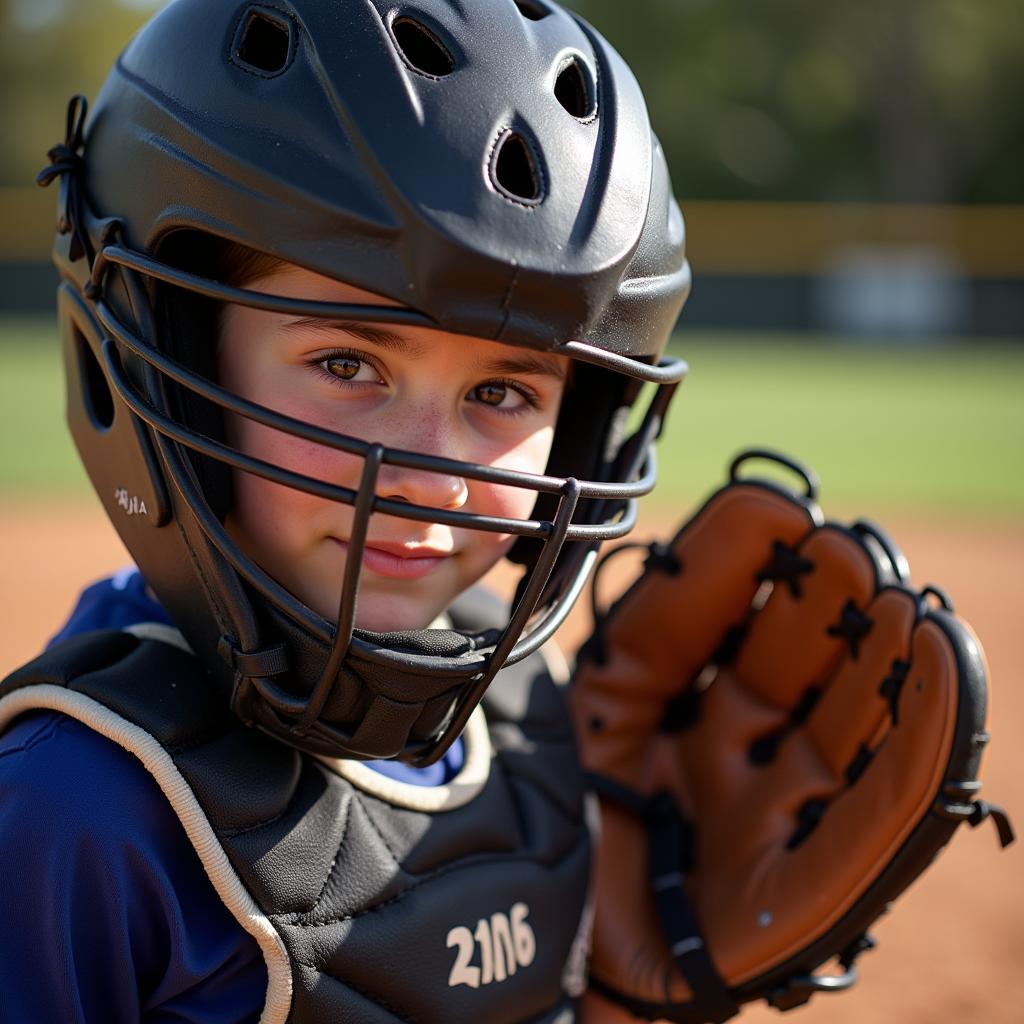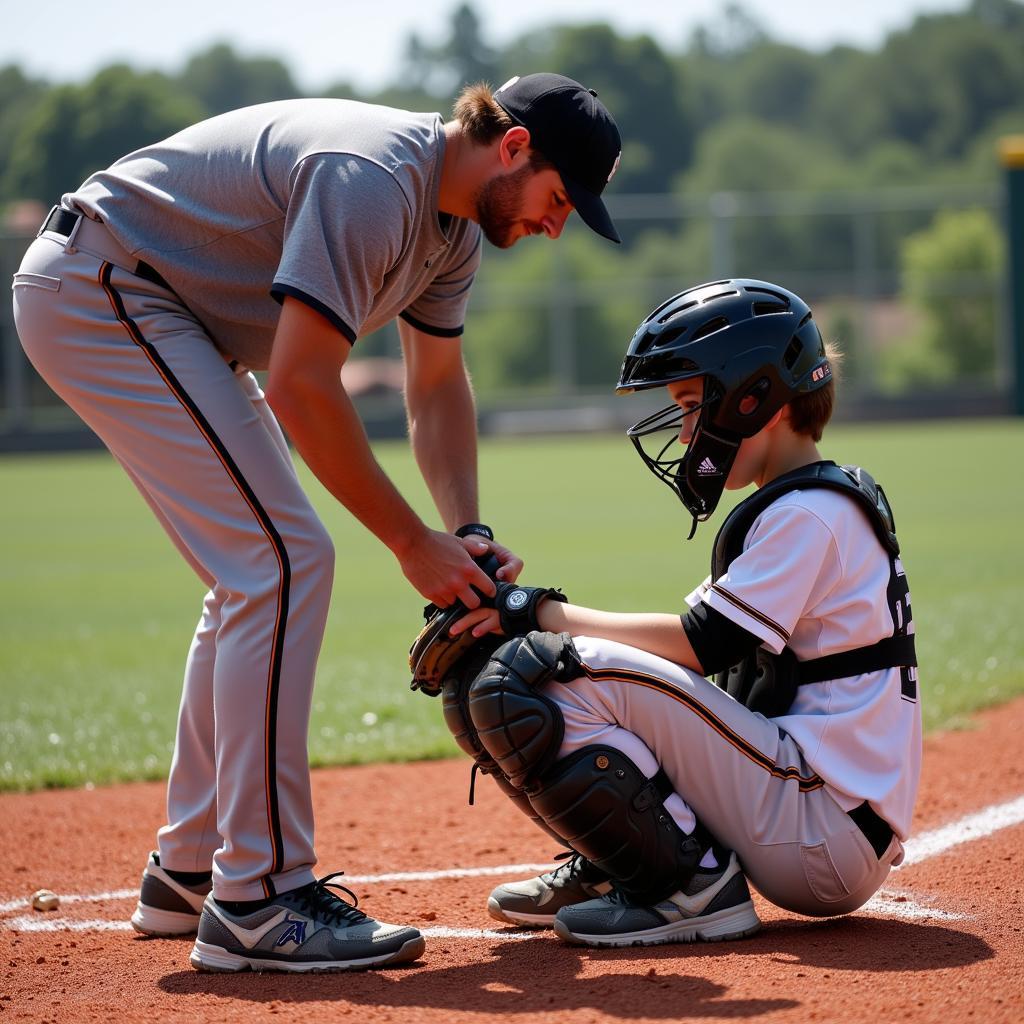All Star Youth Catchers Gear: A Comprehensive Guide
October 10, 2024Choosing the right gear is paramount for young catchers, playing a crucial role in their safety, performance, and enjoyment of the game. From mitts and masks to chest protectors and shin guards, “All Star Youth Catchers Gear” represents not just equipment but an investment in a young athlete’s future in baseball. This comprehensive guide will equip parents and young athletes with the knowledge to make informed decisions when selecting the best gear for their needs.
Understanding the Importance of Quality Catchers Gear
Catcher’s gear differs significantly from other positions on the field. It’s designed to withstand the constant impact of high-speed pitches and the rigors of blocking balls in the dirt. Investing in durable, well-designed gear ensures your young catcher stays protected and comfortable, allowing them to focus on their game.
Essential Gear for Youth Catchers:
1. Catcher’s Mitt:
The catcher’s mitt is arguably the most important piece of equipment. Unlike fielder’s gloves, catcher’s mitts are designed to handle the impact of fastballs and offer greater protection for the hand and wrist.
- Size: Youth catchers should use a mitt specifically designed for their age and hand size. A properly fitted mitt will allow for optimal control and comfort.
- Webbing: Different webbing patterns offer varying levels of ball visibility and closure speed. A closed web provides more protection for younger players, while an open web offers increased visibility.
- Padding and Materials: Look for mitts with ample padding in the palm and thumb areas to absorb shock. High-quality leather will offer better durability and longevity.
2. Catcher’s Mask:
Protecting the head and face is paramount, and a well-fitted mask is non-negotiable.
- Material: Masks are typically made from polycarbonate or a similar impact-resistant material. Choose a lightweight yet durable option.
- Fit and Vision: The mask should fit snugly without obstructing vision. Adjustable straps allow for a customizable fit.
- Throat Protection: Opt for a mask with integrated throat protection to safeguard against foul tips and errant throws.
 Youth Catcher Gear Close Up
Youth Catcher Gear Close Up
3. Chest Protector:
A chest protector safeguards the chest, ribs, and shoulders from the impact of the ball.
- Size and Coverage: The chest protector should cover the entire chest area and extend to the collarbone. Choose a size appropriate for the player’s height and build.
- Protection Level: Youth chest protectors come in various protection levels. Consider the age and playing level of the catcher.
- Comfort and Mobility: Look for lightweight, breathable materials that allow for a full range of motion.
4. Shin Guards:
Shin guards protect the lower legs from foul balls and collisions at the plate.
- Fit: Shin guards should fit snugly without restricting movement. Adjustable straps ensure a secure and comfortable fit.
- Length: Choose shin guards that offer adequate coverage from the knees to the top of the foot.
- Padding and Ventilation: Plentiful padding and breathable materials will enhance comfort and protection.
5. Protective Cup:
While often overlooked, a protective cup is crucial for every young catcher. Choose a cup that fits comfortably and provides adequate protection.
Choosing the Right Size and Fit:
Ill-fitting gear can hinder performance and compromise safety. Always consult size charts and consider the following:
- Try before you buy: Whenever possible, have your young catcher try on the gear to ensure a proper fit.
- Consider growth: Young athletes are constantly growing, so factor in future growth when selecting gear.
- Don’t sacrifice safety for cost: While budget is a consideration, prioritize safety and quality when making your purchase.
 Youth Catcher Gear Fitting
Youth Catcher Gear Fitting
Caring for Your Catcher’s Gear:
Proper care and maintenance can significantly extend the life of your catcher’s gear.
- Clean your gear regularly: Wipe down your gear with a damp cloth after each use to remove dirt and sweat.
- Air dry your gear: Avoid storing damp gear in enclosed spaces to prevent mold and mildew.
- Inspect for wear and tear: Regularly check your gear for signs of damage and replace any worn-out components.
Conclusion:
Equipping your young catcher with high-quality gear is an investment in their safety, performance, and overall enjoyment of the game. By following this comprehensive guide, you can make informed decisions and help your young athlete reach their full potential behind the plate.
FAQs
1. How often should I replace my catcher’s gear?
Catcher’s gear should be replaced when it shows signs of wear and tear or no longer fits properly. Inspect your gear regularly and replace any damaged components promptly.
2. What is the best material for a catcher’s mitt?
High-quality leather is the preferred material for catcher’s mitts, offering durability, comfort, and a good feel for the ball.
3. Can my child share catcher’s gear with a sibling or teammate?
For optimal safety and performance, it is recommended that each catcher has their own properly fitted gear.
Need Help?
Contact us! We are available 24/7 to answer any questions and assist you with finding the perfect all star youth catchers gear.
Phone Number: 0963418788
Email: [email protected]
Address: 2M4H+PMH, Phường Nghĩa Thành, Gia Nghĩa, Đắk Nông, Việt Nam.